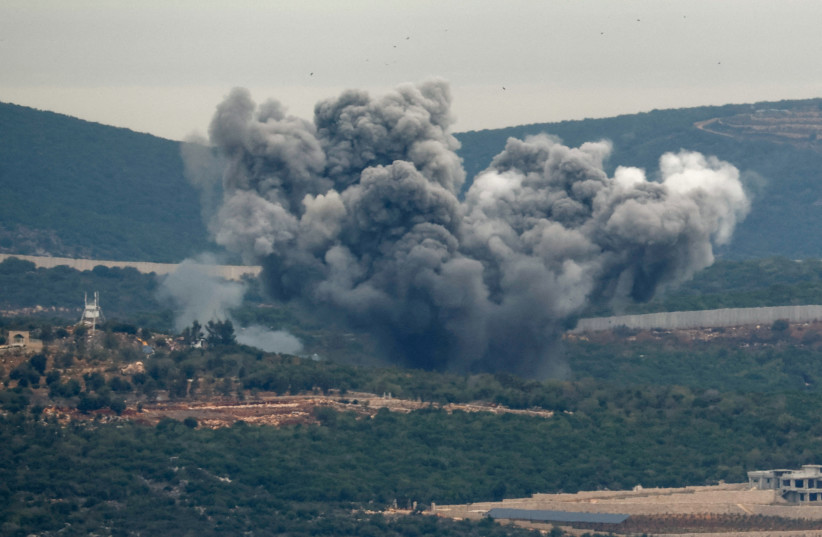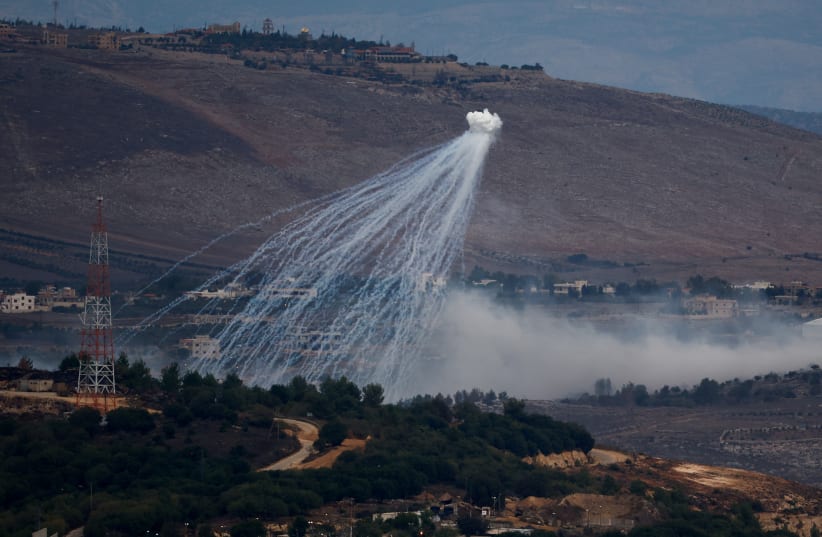The IDF on Tuesday attacked dozens of Hezbollah targets in the Wadi Saluki village of southern Lebanon in a significant escalation between the sides.
Using both air strikes and artillery, the IDF blanketed the area with missiles and shells, where it said Hezbollah had concealed large numbers of military buildings, infrastructure, and weapons.
The village is slightly West of Kriyan Shemona and Menara in the Upper Galilee.
According to the IDF, Hezbollah has repeatedly used the area to carry out attacks against both Israeli soldiers and civilians.
Other than its extensive use of the village and a wide opening to hit many targets in a specific area, there was not necessarily an expectation that the IDF would hit Wadu Saluki more in the future versus another dozen or so villages where Hezbollah also operates.


On Sunday, Hezbollah killed two Israeli civilians when it fired an anti-tank missile at a civilian residence in Yuval Village.
Though that was the only civilian death in the area, Hezbollah also fired anti-tank missiles at a variety of other civilian locations.
This came not long after Hezbollah attacked a key IDF air defense base on January 6 and the IDF Northern Command headquarters on January 9.
Hezbollah is escalating attacks
Likewise, Hezbollah's escalation came after the IDF has spent recent months gradually escalating attacks against Hezbollah forces in various southern Lebanon villages in order to push them back to an area around the Litani River.
In addition, the IDF has taken credit for killing Hezbollah's drone chief in southern Lebanon and has been accused by Hezbollah of killing its Radwan chief as well as Hamas's Deputy Chief Saleh al-Arouri while he was visiting Beirut.
IDF Northern Commander Maj. Gen. Uri Gordon on Tuesday said that the IDF was ready for an even larger escalation if that would be what it takes to press Hezbollah back from the border and return security to Israel's northern residents who evacuated the area in October.
"We are more prepared than ever...we can [go to war] tonight if needed," Gordin said. "We struck many terror cells in the North, more than 150 were destroyed, and a lot of their capabilities have been taken away.
"We are working to peel away Hezbollah's capabilities and pushing it as far back as possible. There is much more to do to bring the desired result of improved security in order to return northern Israeli residents to their homes."
It was unclear if Hezbollah would itself now escalate its attacks - it has 150,000 rockets and mortars, including longer-range precision rockets which can hit most of Israel - or whether both sides would step back from the recent escalation.
Around 180 Hezbollah and Hamas terrorists have been killed in Lebanon since October, while just under 20 IDF soldiers and civilians have been killed.
Israel has expressed hope for a diplomatic solution, including a Hezbollah withdrawal along the lines of UN Resolution 1701 from 2006, but to date, the terror group has resisted, and defense officials have said time is running lower to avoid a larger war.
Earlier Tuesday, the IDF said it sent special ground forces to operate inside Lebanon, eliminating a terror threat in the Ita al-Sha'ab area.
According to Hezbollah-affiliated news outlet al-Mayadeen, a different course of events took place.
It claimed that soldiers from the Maglan commando unit attempted to infiltrate the border near the al-Raheb military site to plant surveillance devices, but were noticed and aborted the mission.
The IDF did not provide more details on the operation.
Events also unfolding in Gaza
Also on Tuesday, Hamas fired 50 rockets from central Gaza on Israel’s South with one direct hit on a store in Netivot, but no reported casualties.
Hamas’s barrage of rockets was especially embarrassing to the IDF as it came from an area of Gaza where only one day earlier, on Monday, the IDF announced it was withdrawing Division 36.
It had said that central Gaza was moving enough in the right direction that even if it was not under full IDF operational control as northern Gaza is, a smaller number of forces, led by Division 99, could handle the job of mopping up the weakened remaining Hamas terror forces.
Pressed about whether the 50 rockets were a sign that Division 36 needed to be returned, IDF sources declined to comment, signaling that the withdrawal of those forces is part of a broader IDF and government hopes to maintain gains in Gaza with smaller forces.
Essentially, the strategy is that withdrawing significant forces will allow most reservists to return to their families and jobs, while also showing the US and other Western allies that the war will cause fewer Palestinian civilian casualties.
IDF sources also declined to explain why the IDF was avoiding parts of central Gaza where portions of Hamas’s leadership are reportedly holed up with some Israeli hostages.
Meanwhile, the military announced on Tuesday that two more soldiers have died, one from wounds sustained in December, and one in battle in central Gaza. Sgt.-Maj. (res.) Nitzan Schessler, 21, from Hadera, died in battles in central Gaza yesterday. Warr. Ofc. Noam Ashram, 37, from Kfar Saba, succumbed to his wounds yesterday after sustaining injuries in a central Gaza battle on December 29.
Also, in the Technology and Logistics Division of the IDF, serious progress was made, rehabilitating 13 out of 14 Gaza border outposts that were centers of destruction, shooting, arson, and looting on October 7.
The effort was led by the head of the IDF and infrastructure department in the wing's logistics division, Col. Maayan Liner, and this week the renovated outposts were officially handed over to the Gaza Division.
This excludes the Nahal Oz outpost, which will be demolished after most of its infrastructure is destroyed.
In addition to the renovated outposts, new battalion command posts will be built in the sector, using construction methods and architecture that have not been used before - subject to the General Staff's work in the Ground Forces, aiming to implement the lessons learned from the war.
Separately, the IDF 646th Brigade, together with Yahalom forces and engineering fighters from the 99th Division, destroyed an underground tunnel system belonging to Hamas that crosses the Nahal al-Hashur in the Gaza Strip, according to a Tuesday IDF statement.
The IDF described the tunnel as being nine meters below the surface and stretching for hundreds of meters. Significantly, it was used by Hamas to transport terrorists from the northern end of Gaza to the southern end.
Operating in the southern Gaza city of Khan Yunis, IDF commando forces launched targeted raids on the offices of high-ranking Hamas officials, the IDF stated on Tuesday.
According to the IDF, during a raid of Hamas’s Southern Khan Yunis Battalion Commander's office, Israeli troops found weapons, ammunition, and grenades, along with some Hamas lookout cameras.
The cameras were subsequently destroyed.
Prior to the operation against the offices of Hamas leadership in Khan Yunis, the IDF’s Firepower Command struck a number of targets in the area, including the headquarters of Palestinian Islamic Jihad.
Walla’s Amir Bohbot contributed to this report.
